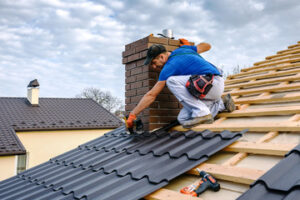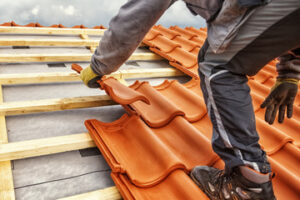Your roof protects your home from the elements. That’s why it should be maintained regularly to prevent problems like leaks.

A well-maintained roof will increase the value of your property and reduce energy costs. Investing in roofing maintenance is an affordable and wise choice. Visit https://www.bostonroofingco.com/ to learn more.
If you have experienced leaks around chimneys, skylights or vents, then chances are that your roof flashing needs attention. The flashing is the metal strips that seal areas where a change in the roofing material occurs. It is typically made of copper, steel or aluminum. It is important that roof flashing be in good condition to avoid water intrusion into your home, as well as other structural damage such as ruined drywall, mold, and rotting wood.
There are several different types of roof flashing, each with their own purpose. Valley flashing (the most common) is a series of metal strips that look like an upside down “T” and is installed in the area where two different roof planes meet. Counter flashing is installed above step flashing and helps to protect the base of chimneys or walls from water intrusion. Drip edge flashing is a long, continuous piece of flashing that is positioned along the edges of the roof.
When flashing is not properly installed or in good repair, it can become loose and dislodged. This is especially true in high-wind conditions, when it can be blown off completely. It is recommended that you inspect roof flashing during clear days, using a pair of binoculars and paying close attention to any areas where penetrations are located.
If you find that the flashing has become loose or dislodged, you should first attempt to re-seal it with caulking or roofing cement. If you are unable to get the job done yourself, you should hire a professional to do it for you.
Before you start repairing any faulty flashing, make sure that you have removed all debris from the area. You should also clean the flashing, using soapy water or a mild acidic solution such as vinegar or lemon juice, to remove any rust or corrosion. This should be done regularly, at least once a year.
If you find that the flashing is rusted or corroded, it is best to call in professionals to assess and carry out extensive repairs. Otherwise, the problem may get worse and lead to other issues such as leaking or roof collapse.
Inspect the Caulk
As most homeowners know, caulking is an important part of roof maintenance. It is used to seal cracks and gaps that could allow water to leak into your home. This can help with energy savings and reducing water damage caused by rain or snow. It can also reduce the risk of insects and other pests making their way into your home. While it may seem like a simple enough task to do on your own, many do-it-yourselfers make common mistakes when performing this job.
First of all, if you are going to be inspecting the caulking on your own, it is essential that you use proper safety precautions. This includes wearing gloves, using a ladder that is sturdy and secure, and being aware of the risks involved in climbing up onto your roof. If you aren’t comfortable doing this yourself, a professional should be hired to do the inspection for you.
During an inspection, the inspector will look for any signs of wear and tear in the caulking on your roof. This includes looking for loose shingles, broken shingle tabs, and cracked or peeling caulking. They will also check the ridges of your roof to look for any areas where the shingles are beginning to break down and begin to form holes in your roof system.
The inspector will also look for any areas where the roof meets other components like chimneys, vents, and exterior lights. These areas are usually sealed with a metal flashing and caulking, and over time, they can rust or warp, or the caulking can become corroded or missing altogether. If this happens, it can lead to a leaky roof and a host of other problems for your home.
You should also be careful when choosing the type of caulking to use. There are many different types available on the market, and each one has its own benefits and drawbacks. For example, butyl rubber caulk is highly resistant to water, while latex caulking is easy to work with and clean up, but doesn’t hold up well in high-moisture environments.
Clean the Gutters
Clogged gutters can lead to damage to the roof and foundation of your house. It is important to clean your gutters at least twice a year to prevent the build-up of debris and prevent water damage to your home. If you are cleaning the gutters yourself, make sure to wear work gloves and use a ladder that is stable.
You can use a garden trowel or a long gutter scoop to remove the leaves, twigs, and moss that have accumulated in your gutters. Once you have removed the debris, flush the gutters with a hose.
Another important step in gutter maintenance is preventing the build-up of ice dams, which can damage your gutter system and even your roof structure. It is possible to prevent ice dams by improving your attic insulation and ventilation.
Finally, if you notice any branches or plants that are growing too close to the roof or your gutters, consider trimming them back. This will help to prevent damage from storms and provide a safer environment for squirrels and other critters. It is also a good idea to trim trees that are near the house, as these can become a hazard during a storm and may fall onto your home.
If you don’t want to get up on a ladder, you can try using a gutter blower that is attached to a hose to clean the debris from the roof. However, this can be dangerous, so it is best to leave this job to the professionals.
If you have a professional service clean your gutters, they will also be able to check for any signs of damage that need to be repaired. This can save you a lot of time and money in the long run. In addition, they will also be able to clean the downspouts and clear away any clogs. If you are considering doing this yourself, it is a good idea to use a ladder stand off and follow the 4:1 rule, which states that your ladder should be 1 foot away from the wall it is leaning on for every 4 feet of height.
Schedule a Roof Inspection
A well-maintained roof increases the value of your home, and it can make it easier to sell if you’re planning to move. Inspecting your roof before you put it on the market will help you identify and address any issues that might prevent a successful sale.
A professional inspector can look for potential damage and signs of wear and tear that you may not see, like loose or missing shingles, cracks in flat roofing materials, damaged flashing around chimneys and vents, and moss or algae growth. In addition, they can examine your roof for moisture problems, which are the leading cause of roof leaks.
Regular inspections can also save you money. By identifying small problems and addressing them quickly, you can avoid costly repairs and prolong the life of your roof. In fact, some roofing warranties require that you have a roof inspection performed at least once per year to ensure the warranty remains valid.
In addition to protecting your home from water damage, a properly maintained roof can help regulate the temperature in your house and reduce energy costs. The experts at Elevate can evaluate the condition of your insulation, ventilation, and roof materials to make sure they’re performing as they should. We can also assess energy efficiency, looking for areas of heat loss that could be contributing to higher utility bills.
When you schedule a roof inspection, you can expect the inspector to provide a comprehensive written assessment of your roof’s condition and recommend any repairs or maintenance that are needed. They will also include a cost estimate for any recommended work, making it easy to budget for your roofing needs.
The best time to schedule a roof inspection depends on the season. For example, it’s a good idea to have your roof inspected in the spring, after the harsh winter weather, and after severe storms.
Once the inspector has completed their assessment, they will meet with you to discuss their findings and recommendations. At this point, you can decide whether or not to have the repairs carried out and request a quote. Then, when the work is done, your inspector can return to perform another inspection and confirm that the repairs were effective.
